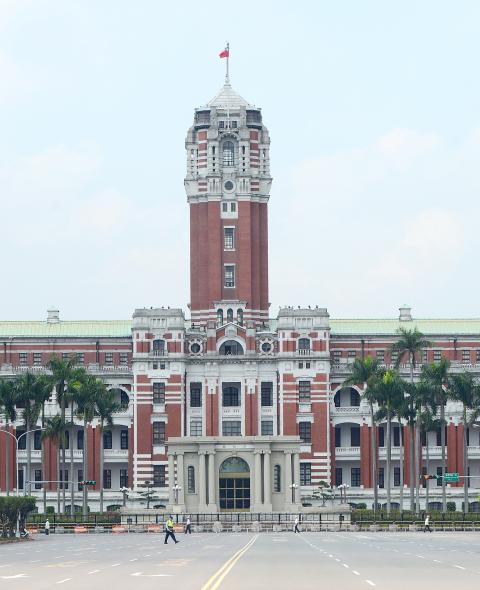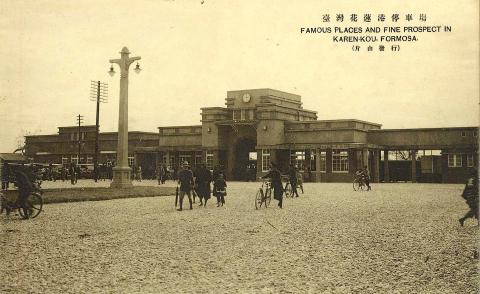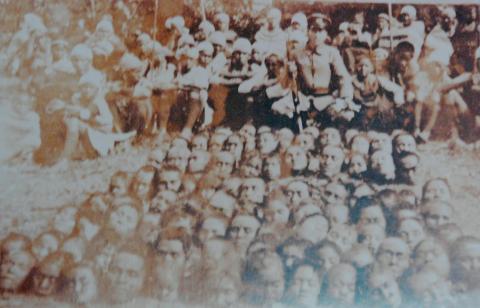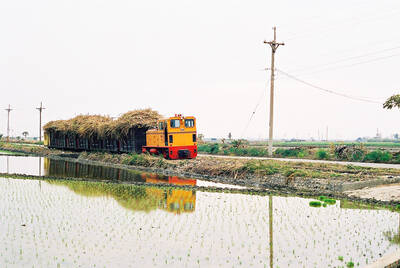The Japanese colonial period (1895-1945) is perceived quite differently in Taiwan: while pro-China groups consider it negatively and emphasize the colonial aspect, pro-localization groups see it as a period of strict but fair rule, when Taiwan made major strides in infrastructure, health care, agriculture and governance. This latter group compares it positively to the repressive Chinese Nationalist Party (KMT) White Terror era, which followed from 1945 through 1987.
Taiwan was ceded to Japan by the Qing Dynasty under the provisions of the Treaty of Shimonoseki of April 17, 1895, which ended the 1894-1895 Sino-Japanese war. The Qing had lost the war primarily because during the 20 years since the Meiji Restoration, Japan had been able to build up a modern army and navy, easily defeating the Chinese fleet.
The treaty was signed on behalf of the Qing Imperial government by viceroy Li Hung-chang (李鴻章), and included the following four provisions: China recognizes independence of Korea; it cedes Taiwan and the Pescadores to Japan in perpetuity; it pays 200 million taels war indemnity; and opens port-cities to Japan.

Photo: Sung Hsiao-hai, Taipei Times
RESISTANCE
Back in Taiwan, the treaty came as a shock. Neither the population nor officials had been consulted. Governor Tang Ching-sung (唐景崧) was convinced by the local gentry to declare independence on May 23 1895, and a new government was inaugurated on May 25. “Black Flag” general Liu Yung-fu (劉永福) commanded the army of some 100,000 soldiers and Chen Chi-tung (陳季同), an experienced diplomat who spoke French fluently, served as foreign minister.
However, six days after the Formosa Republic declared independence, Japanese troops under general Kawamura Kageaki landed near Keelung and started to move South. The Qing soldiers and the local militia were no match for the well-armed and trained Japanese, and on June 7, the Japanese army entered Taipei.

Photo: Hua Meng-ching, Taipei Times
During the next five months, the Japanese pushed further South. Conquering Taipei had been relatively easy: the Qing officials and soldiers had no close connection to the territory, and gave up easily, fleeing without much of a fight.
But in Central Taiwan, the local militia were strongly attached to “their” territory and put up stiff resistance, which resulted in the Aug. 27 Battle of Baguashan (八卦山戰役) near Changhua. The Japanese onslaught, however, proved unstoppable, and on Oct. 21 they captured the last opposition strong-hold in Tainan.
After the fall of Tainan, the Japanese declared Taiwan pacified, though there uprisings for many years to come because of widespread resistance from both the Hoklo and Hakka speaking populations as well as Aborigines. In fact, many historians now argue that a “Taiwanese” identity grew out of Japanese oppression.

Photo courtesy of Liang Chih-Chung
‘MODEL COLONY’
In the initial years of Japanese occupation, governor-generals followed in quick succession. It wasn’t until the fourth governor general, army general Kodama Gentaro (1898 to 1906) that Japanese rule stabilized. He started major infrastructure projects, building 10,000km of roads and railroads from Keelung in the north to Kaohsiung in the south. The governor-general was ably assisted by a civilian administrator, Goto Shinpei, who laid the groundwork for Taiwan’s modern infrastructure development. A doctor by training, he set up hospitals, sanitation systems and modern harbors in Keelung and Kaohsiung.
Shinpei also implemented standardization of currency and weights, oversaw the construction of major buildings (like the governor-general’s office, Presidential office) and major railway stations and brought in agricultural experts to enhance rice and sugar production. Taiwan became Japan’s “model colony.”
Particularly in the period 1902-1918 the Japanese tried to entice both the Hoklo and Hakka farmers and Aborigines with incentives: jobs and money. Japanese policemen were deployed, maintaining strict control over every aspect of life.
NEW TAIWANESE ELITES
After 1920 there was more of an educated elite: a new generation had grown up under Japanese rule, and Japan had gradually opened up high schools and universities to students from Taiwan. Events that had a lasting impact on these students were the 1911 revolution in China, Korea’s 1919 uprising against Japan and, in the same year, the formation of the League of Nations.
Particularly influential were US President Woodrow Wilson’s 14 points. Made in a speech to the US Congress in 1918, he stated in point five that a free, open-minded, and absolutely impartial adjustment of all colonial claims, based upon a strict observance of the principle that in determining all such questions of sovereignty the interests of the populations concerned must have equal weight with the equitable claims of the government whose title is to be determined.
In Taiwan, this led to the home-rule movement: a loose coalition of people and organizations pushing for more say by the local population in their own affairs. They conducted meetings, workshops, awareness campaigns and, from 1921 to 1935, a yearly delegation to the Japanese Diet to petition for Taiwanese representation in the Representative Assembly.
These were all denied.
The Taiwan Cultural Association, established in 1920 and led by key campaigners such as Chang Wei-shui (蔣渭水), Lin Hsien-tang (林獻堂) and Tsai Pei-huo (蔡培火), was the most prominent organization to call for more self-determination. Other organizations followed in later years: The Taiwanese Farmers’ Association (台灣農民協會) in 1926, the Taiwanese Workers League (台灣工友總聯盟) in 1928 and the Taiwan Local Autonomy Alliance (臺灣地方自治聯盟) from 1930-1937.
By the end of the 1920s, the program of universal education and Japanization had taken hold and for some time there was rather widespread stability and prosperity. The Japanese had a “strict but fair” system: Police maintained tight control, particularly in the mountain areas. The educational system evolved a Taiwanese upper-middle class that thirsted for democratic representation.
The tight Japanese control in the mountain areas led to a major conflict with the Atayal and Seediq communities on Oct. 27 1930: the Wushe Incident (霧社事件). Angered by police misconduct, forced labor and disregard for Aboriginal beliefs and customs, the Seediq exploded in anger, and, led by chief Mona Rudao, attacked a flag-raising ceremony at an elementary school, killing 132 Japanese and wounding 215 others.
The Japanese authorities immediately dispatched an army of some 2,700 soldiers, which swarmed into the mountains to hunt down the Atayal and Seediq. In a 50-day campaign some 275 Aborigines were killed, while almost 300 women committed suicide. For both sides it had become a matter of protecting their “dignity and honor.” The events formed the basis for the recent movie Warriors of the Rainbow: Seediq Bale (賽德克巴萊).
ASSIMILATION
The assimilation policy, begun around 1919 (education and Japanization, combined with strict control by police), continued. It was started by the first civilian governor-general, Den Kenjiro, who coined it “Doka” (同化, integration). It considered Taiwan an extension of itself, and involved local governance, a public school system and symbolic representation in the House of Peers (Upper House of the Imperial Diet), which continued until 1937.
Interestingly, during all these years, there was no claim of sovereignty over Taiwan from China’s leaders. Both the KMT and the Chinese Communist Party (CCP) accepted Taiwan as a Japanese colony.
In 1926, KMT leader Chiang Kai-shek (蔣介石) even proclaimed that Taiwan should become independent, from Japan of course. A number of years later, CCP leader Mao Tse-tung (毛澤東) also expressed his support for Taiwan independence, in a 1937 interview with American writer Edgar Snow that he recounts in Red Star over China: “…we will extend them (the Koreans) our enthusiastic help in their struggle for independence. The same thing applies for Taiwan.”
By the early 1930s, things started to change: the relatively liberal Taisho Period (1912-1926) ended as militarists took over in Tokyo: in 1931 Japan moved into Manchukuo. In 1933 it withdrew from the League of Nations and in 1937 the Marco Polo bridge Incident took place, starting the war with China.
BASE FOR WAR
These developments had consequences for Taiwan: it became the Southern base, from which Japan planned to move into South-East Asia. There was a major industrial and infrastructure expansion: factories churned out products for Japan’s war effort. The Kominka Movement (皇民化運動) soon followed, a policy to make Taiwanese loyal subjects of the Japanese empire.
This led to a total Japanisation of society, desegregation of the school system by 1941 and participation in the war effort, including military draft: some 200,000 served. The War with China effectively meant a state of war for Taiwan, more than four years before the attack on Pearl Harbor. After December 1941, as the war intensified, Taiwan became increasingly the target of American bombing, aimed at those Japanese factories participating in the war effort.
A significant moment for Taiwan occurred in November 1943, when Allied leaders Franklin Roosevelt, Winston Churchill and Chiang Kai-shek convened in Cairo, Egypt to make plans for a post-war world. In a press release, they declared their intention to hand over Manchuria, Formosa and the Pescadores to the Republic of China. This intention was reiterated at Potsdam, but was never formally implemented: in September 1945, General McArthur only authorized temporary occupation of Formosa on behalf of the Allied Forces (General Order No. 1).
SURRENDER
On Oct. 25 1945 Japanese governor-general Rikichi Ando signed the surrender document with ROC general Chen Yi (陳儀). But this did not constitute a former transfer of sovereignty, which could only be done through a formal international treaty, to be negotiated by all parties involved. This was the 1951 San Francisco Peace Treaty, under which Japan formally ceded sovereignty over Taiwan.
However, the Treaty did not specify a recipient, as neither the ROC nor the PRC were present at San Francisco. Major participants such as Great Britain, France and Egypt took the position that Taiwan’s status needed to be left undetermined until a solution was found, taking into account the principle of self-determination and the expressed desire of the inhabitants of Taiwan. The US agreed, and until this day takes the formal position that Taiwan’s status is undetermined, and needs to be determined peacefully, with the assent of the people of Taiwan.
— Gerrit van der Wees is a former Dutch diplomat. From 1980 through 2015 he served as editor of ‘Taiwan Communique.’ He currently teaches history of Taiwan at George Mason University in Fairfax, Virginia.

This is the year that the demographic crisis will begin to impact people’s lives. This will create pressures on treatment and hiring of foreigners. Regardless of whatever technological breakthroughs happen, the real value will come from digesting and productively applying existing technologies in new and creative ways. INTRODUCING BASIC SERVICES BREAKDOWNS At some point soon, we will begin to witness a breakdown in basic services. Initially, it will be limited and sporadic, but the frequency and newsworthiness of the incidents will only continue to accelerate dramatically in the coming years. Here in central Taiwan, many basic services are severely understaffed, and

Jan. 5 to Jan. 11 Of the more than 3,000km of sugar railway that once criss-crossed central and southern Taiwan, just 16.1km remain in operation today. By the time Dafydd Fell began photographing the network in earnest in 1994, it was already well past its heyday. The system had been significantly cut back, leaving behind abandoned stations, rusting rolling stock and crumbling facilities. This reduction continued during the five years of his documentation, adding urgency to his task. As passenger services had already ceased by then, Fell had to wait for the sugarcane harvest season each year, which typically ran from

It is a soulful folk song, filled with feeling and history: A love-stricken young man tells God about his hopes and dreams of happiness. Generations of Uighurs, the Turkic ethnic minority in China’s Xinjiang region, have played it at parties and weddings. But today, if they download it, play it or share it online, they risk ending up in prison. Besh pede, a popular Uighur folk ballad, is among dozens of Uighur-language songs that have been deemed “problematic” by Xinjiang authorities, according to a recording of a meeting held by police and other local officials in the historic city of Kashgar in

It’s a good thing that 2025 is over. Yes, I fully expect we will look back on the year with nostalgia, once we have experienced this year and 2027. Traditionally at New Years much discourse is devoted to discussing what happened the previous year. Let’s have a look at what didn’t happen. Many bad things did not happen. The People’s Republic of China (PRC) did not attack Taiwan. We didn’t have a massive, destructive earthquake or drought. We didn’t have a major human pandemic. No widespread unemployment or other destructive social events. Nothing serious was done about Taiwan’s swelling birth rate catastrophe.